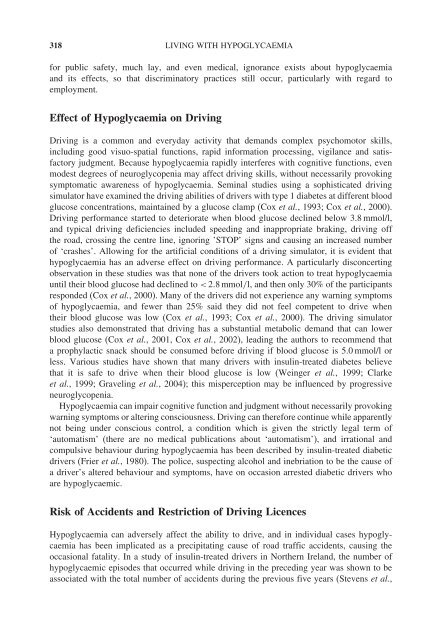Hypoglycaemia in Clinical Diabetes
Hypoglycaemia in Clinical Diabetes
Hypoglycaemia in Clinical Diabetes
- No tags were found...
Create successful ePaper yourself
Turn your PDF publications into a flip-book with our unique Google optimized e-Paper software.
318 LIVING WITH HYPOGLYCAEMIAfor public safety, much lay, and even medical, ignorance exists about hypoglycaemiaand its effects, so that discrim<strong>in</strong>atory practices still occur, particularly with regard toemployment.Effect of <strong>Hypoglycaemia</strong> on Driv<strong>in</strong>gDriv<strong>in</strong>g is a common and everyday activity that demands complex psychomotor skills,<strong>in</strong>clud<strong>in</strong>g good visuo-spatial functions, rapid <strong>in</strong>formation process<strong>in</strong>g, vigilance and satisfactoryjudgment. Because hypoglycaemia rapidly <strong>in</strong>terferes with cognitive functions, evenmodest degrees of neuroglycopenia may affect driv<strong>in</strong>g skills, without necessarily provok<strong>in</strong>gsymptomatic awareness of hypoglycaemia. Sem<strong>in</strong>al studies us<strong>in</strong>g a sophisticated driv<strong>in</strong>gsimulator have exam<strong>in</strong>ed the driv<strong>in</strong>g abilities of drivers with type 1 diabetes at different bloodglucose concentrations, ma<strong>in</strong>ta<strong>in</strong>ed by a glucose clamp (Cox et al., 1993; Cox et al., 2000).Driv<strong>in</strong>g performance started to deteriorate when blood glucose decl<strong>in</strong>ed below 3.8 mmol/l,and typical driv<strong>in</strong>g deficiencies <strong>in</strong>cluded speed<strong>in</strong>g and <strong>in</strong>appropriate brak<strong>in</strong>g, driv<strong>in</strong>g offthe road, cross<strong>in</strong>g the centre l<strong>in</strong>e, ignor<strong>in</strong>g ’STOP’ signs and caus<strong>in</strong>g an <strong>in</strong>creased numberof ‘crashes’. Allow<strong>in</strong>g for the artificial conditions of a driv<strong>in</strong>g simulator, it is evident thathypoglycaemia has an adverse effect on driv<strong>in</strong>g performance. A particularly disconcert<strong>in</strong>gobservation <strong>in</strong> these studies was that none of the drivers took action to treat hypoglycaemiauntil their blood glucose had decl<strong>in</strong>ed to < 28 mmol/l, and then only 30% of the participantsresponded (Cox et al., 2000). Many of the drivers did not experience any warn<strong>in</strong>g symptomsof hypoglycaemia, and fewer than 25% said they did not feel competent to drive whentheir blood glucose was low (Cox et al., 1993; Cox et al., 2000). The driv<strong>in</strong>g simulatorstudies also demonstrated that driv<strong>in</strong>g has a substantial metabolic demand that can lowerblood glucose (Cox et al., 2001, Cox et al., 2002), lead<strong>in</strong>g the authors to recommend thata prophylactic snack should be consumed before driv<strong>in</strong>g if blood glucose is 5.0 mmol/l orless. Various studies have shown that many drivers with <strong>in</strong>sul<strong>in</strong>-treated diabetes believethat it is safe to drive when their blood glucose is low (We<strong>in</strong>ger et al., 1999; Clarkeet al., 1999; Gravel<strong>in</strong>g et al., 2004); this misperception may be <strong>in</strong>fluenced by progressiveneuroglycopenia.<strong>Hypoglycaemia</strong> can impair cognitive function and judgment without necessarily provok<strong>in</strong>gwarn<strong>in</strong>g symptoms or alter<strong>in</strong>g consciousness. Driv<strong>in</strong>g can therefore cont<strong>in</strong>ue while apparentlynot be<strong>in</strong>g under conscious control, a condition which is given the strictly legal term of‘automatism’ (there are no medical publications about ‘automatism’), and irrational andcompulsive behaviour dur<strong>in</strong>g hypoglycaemia has been described by <strong>in</strong>sul<strong>in</strong>-treated diabeticdrivers (Frier et al., 1980). The police, suspect<strong>in</strong>g alcohol and <strong>in</strong>ebriation to be the cause ofa driver’s altered behaviour and symptoms, have on occasion arrested diabetic drivers whoare hypoglycaemic.Risk of Accidents and Restriction of Driv<strong>in</strong>g Licences<strong>Hypoglycaemia</strong> can adversely affect the ability to drive, and <strong>in</strong> <strong>in</strong>dividual cases hypoglycaemiahas been implicated as a precipitat<strong>in</strong>g cause of road traffic accidents, caus<strong>in</strong>g theoccasional fatality. In a study of <strong>in</strong>sul<strong>in</strong>-treated drivers <strong>in</strong> Northern Ireland, the number ofhypoglycaemic episodes that occurred while driv<strong>in</strong>g <strong>in</strong> the preced<strong>in</strong>g year was shown to beassociated with the total number of accidents dur<strong>in</strong>g the previous five years (Stevens et al.,
















